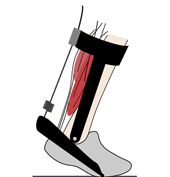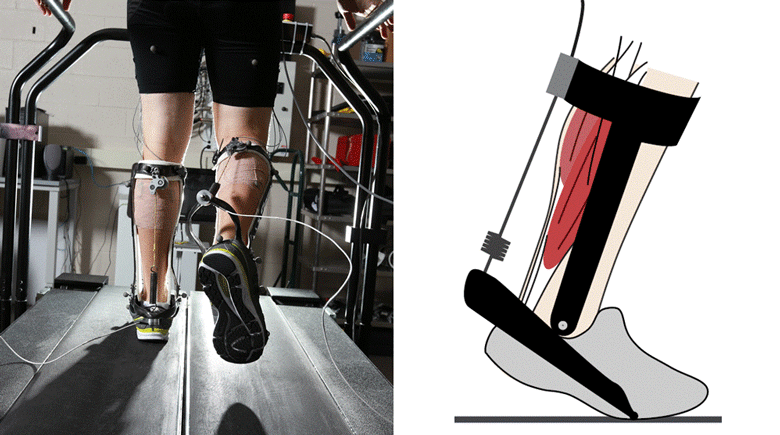Gregory S. Sawicki and Nabil S. Khan, North Carolina State University and University of North Carolina at Chapel Hill
A recent experiment demonstrated that when humans wear unpowered elastic ankle exoskeletons with intermediate spring stiffness they can reduce their metabolic energy cost to walk by ~7%. Springs that are too compliant or too stiff have little benefit.
In this article we employed modeling and simulation to explore the muscle-level mechanisms for the ‘sweet-spot’ in stiffness during exoskeleton assisted walking. We developed a simple lumped, uniarticular musculoskeletal model of the plantarflexors operating in parallel with an elastic ‘exo-tendon’. Using an inverse approach with constrained kinematics and kinetics, we rapidly simulated human walking over a range of exoskeleton stiffness values and examined the underlying neuromechanics and energetics of the biological plantarflexors.
Stiffer ankle exoskeleton springs resulted in larger decreases in plantarflexor muscle forces, activations and metabolic energy consumption. However, in the process of unloading the compliant biological muscle-tendon unit (MTU), the muscle fascicles (CE) experienced larger excursions that negatively impacted series elastic element (SEE) recoil that is characteristic of a tuned ‘catapult mechanism’.
The combination of disrupted muscle-tendon dynamics and the need to produce compensatory forces/moments to maintain overall net ankle moment invariance could explain the ‘sweet spot’ in metabolic performance at intermediate ankle exoskeleton stiffness. Future work will aim to provide experimental evidence to support the model predictions presented here using ultrasound imaging of muscle-level dynamics during walking with elastic ankle exoskeletons.
Our results highlight that engineers must account for the muscle-level effects of exoskeleton designs in order to achieve maximal performance objectives.
Keywords: Elastic ankle exoskeleton, muscle-tendon dynamics, computer simulation


